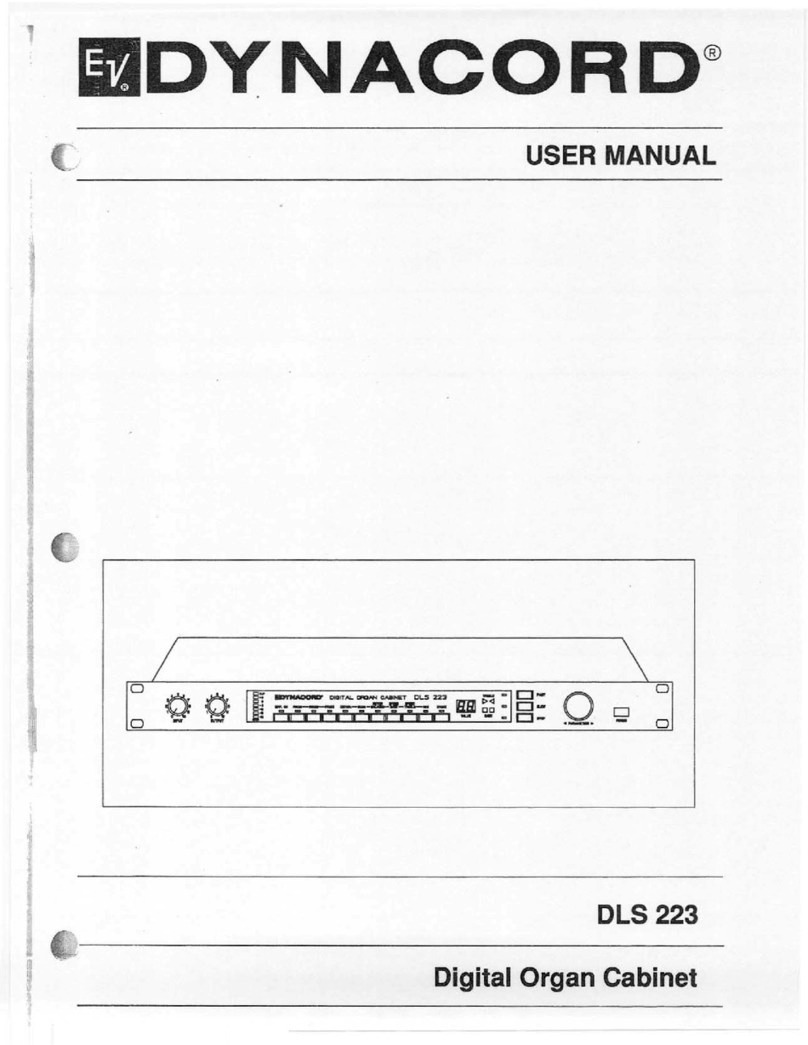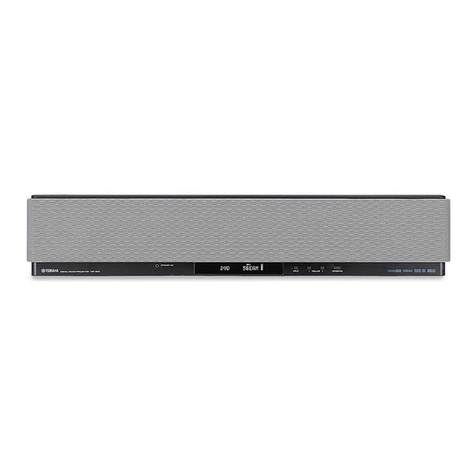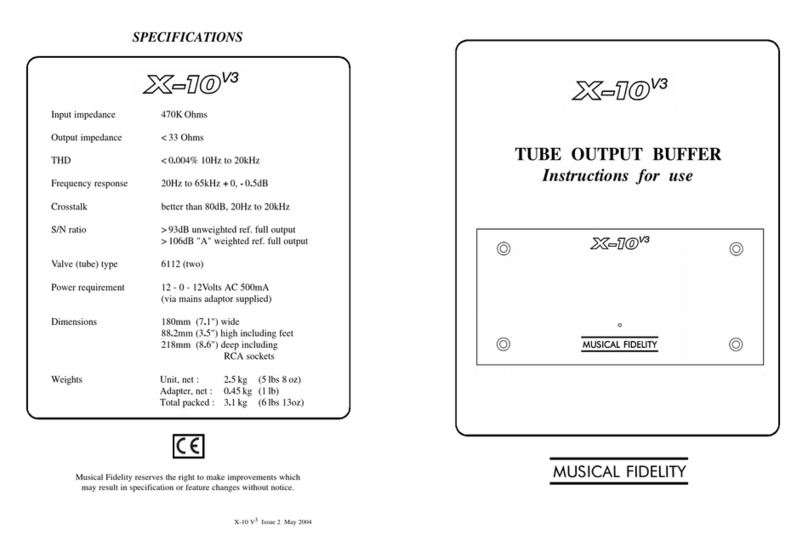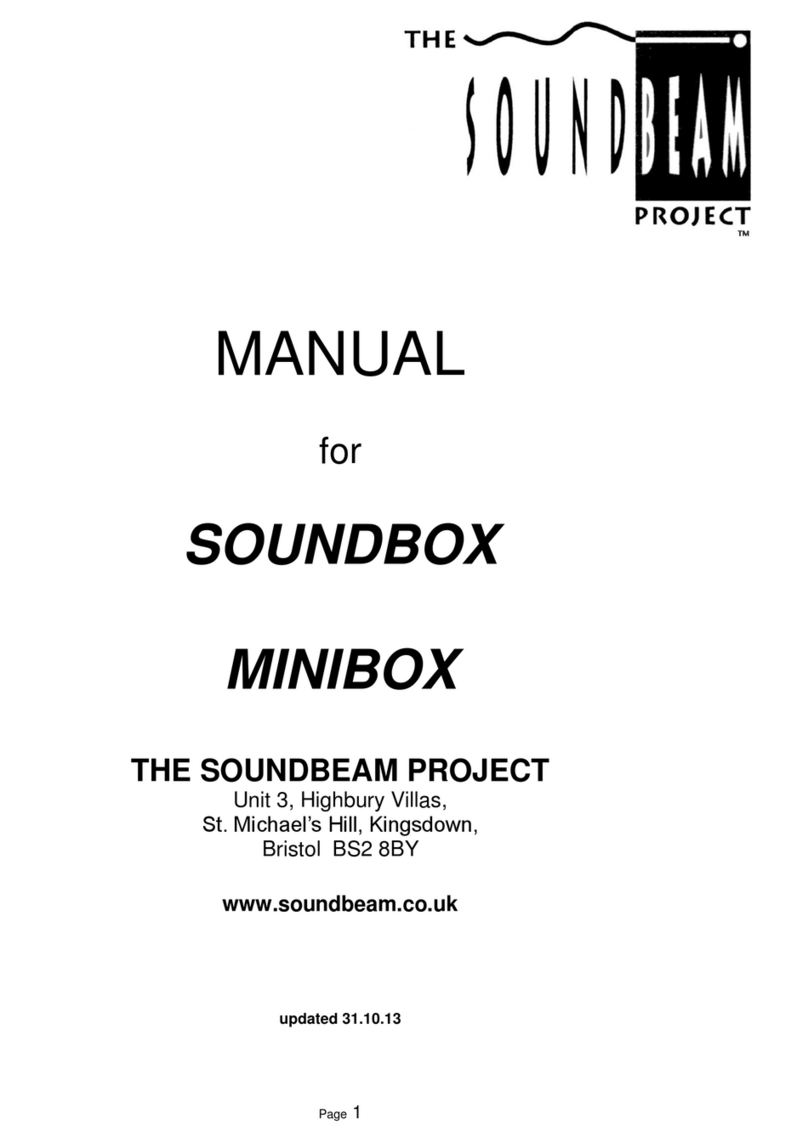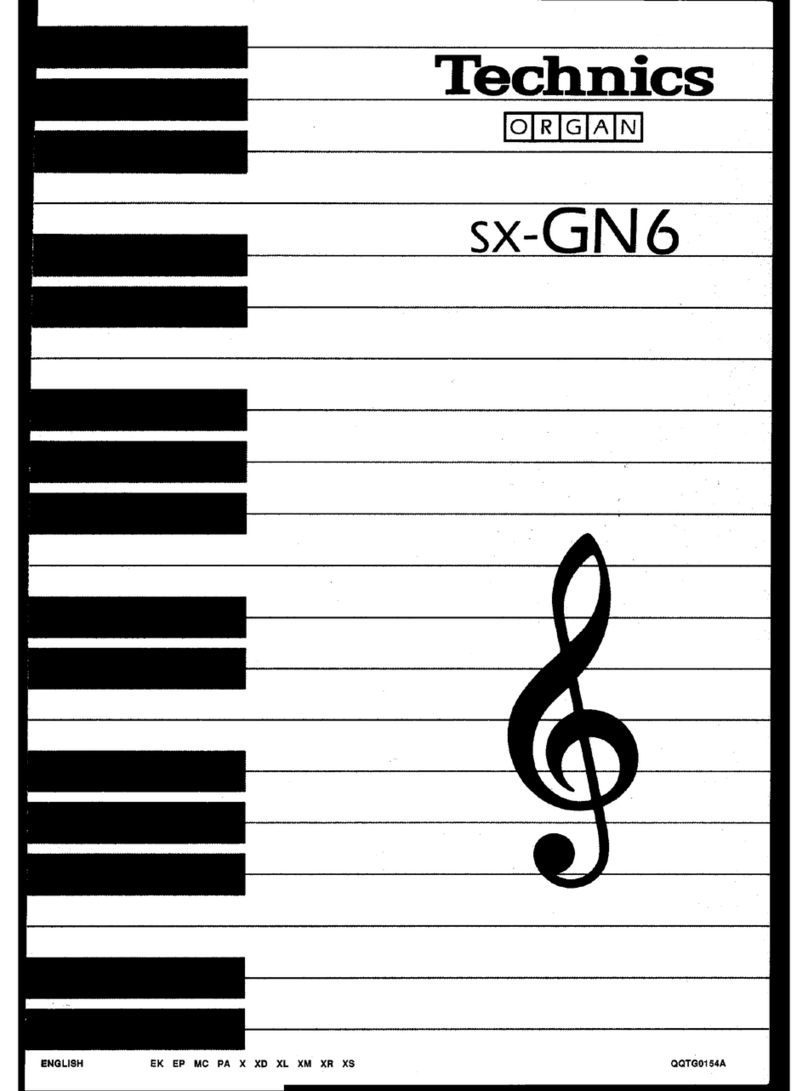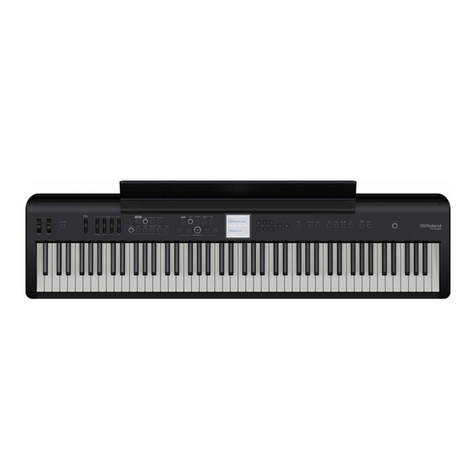Manikin Memotron User manual

MEMOTRON
Rack
OS v1.1
User Manual

Preface
Many thanks for purchasing the Memotron Rack. The Memotron Rack enables you to reproduce the famous
sound of the original instrument with highest authenticity. Thanks to latest digital technology, the Memotron
Rack is easy to use and most reliable in every stage and studio situation.
To become familiar with the Memotron Rack’s capabilities, we recommend you to take a break and study
(and internali e...) this manual first. Enjoy your Memotron Rack!
Your Manikin team
The Memotron Rack development team:
Thorsten Feuerherdt : Hardware, Design
Markus Horn : Software, Design
Mario Schönwälder : Beta testing
Klaus Hoffmann-Hoock : Sounds, Beta testing, user manual, sound collection user manuals
Version : June 2010
Special thanks to
Till Kopper, Stephen Parsick, Christian Peters, Shawn Cleary, Thomas Fanger, Andreas Schneider, Evi
Kruckenhauser, Nicole Lehmann, Kathja, Marit and Niels and all others we might have forgotten to mention
here.
Note
Manikin Electronic will not assume any responsibility for errors which may occur in this manual. The content
of these instructions is subject to change without prior notice. When this manual was created, good care was
taken to exclude any mistakes and contradictions. Manikin Electronic will not accept any guarantees for this
manual except those provided by commercial law.
No part of this user manual is allowed to be reproduced without the expressly written consent of the
manufacturer.
Manikin Electronic, Lipaer Straße 5, D-12203 Berlin, Germany

Table of contents
Introduction..........................................................................................................................1
About this manual.............................................................................................................................1
Symbols used.............................................................................................................................. 1
Marking of parameters.................................................................................................................1
General safety instructions...............................................................................................................2
Suitable location.......................................................................................................................... 2
Mains connection......................................................................................................................... 2
Operation..................................................................................................................................... 2
Maintenance................................................................................................................................ 2
Proper use................................................................................................................................... 2
Controls & Connectors........................................................................................................
Front................................................................................................................................................. 3
Rear................................................................................................................................................. 3
Setting Up.............................................................................................................................4
Unpacking........................................................................................................................................ 4
Installation........................................................................................................................................ 4
Connections..................................................................................................................................... 4
Basic Operation....................................................................................................................5
Power On......................................................................................................................................... 5
Power Off......................................................................................................................................... 5
Realtime Sound-manipulation Functions..........................................................................................5
Menu-driven Functions..................................................................................................................... 6
Track-Menu ..........................................................................................................................8
Load Tracks..................................................................................................................................... 8
Save Tracks..................................................................................................................................... 9
Delete Tracks................................................................................................................................... 9
Initialise Tracks...............................................................................................................................10
Multi Functions...................................................................................................................11
Loading Multis................................................................................................................................ 11
Saving Multis.................................................................................................................................. 12
Deleting Multis................................................................................................................................12
Initialise Multis................................................................................................................................ 13
Storage Device Functions.................................................................................................14
Changing the Memory Card...........................................................................................................14
Sound-Settings...................................................................................................................15
Blending Tracks (Mix)..................................................................................................................... 16
Effect-Setup........................................................................................................................17
MIDI Setup...........................................................................................................................18
Tracks Positioning..........................................................................................................................19

Operation-System Update / Info-Page.............................................................................20
Appendix.............................................................................................................................21
Product-Support............................................................................................................................. 21
Technical data................................................................................................................................ 22
Disposal......................................................................................................................................... 22
MIDI Implementation Chart.............................................................................................................24
Glossary......................................................................................................................................... 25

Introduction
Even if you are perfectly used to electronic instruments and studio equipment, it will be useful to read
this manual entirely. It will help you to get the best out of your Memotron Rack in shortest time.
About the Memotron Rack
The Memotron Rack is an advanced sample playback based musical instrument to reproduce a
famous, specific and genuine sound in highest audio quality. Thanks to its digital technology, it is most
reliable and easy to use. Features are:
•Access to up to six sounds simultaneously
•Fully polyphony
•Internal effect processor
•Complete MIDI-implementation
•Data storage on Compact-Flash-Card
•Compatible with G-Media M-Tron® sound library
The special characteristics of the original have been carefully emulated. This includes a maximum
duration of a played note of about 8 seconds (about 16 seconds at HALF SPEED).
The Memotron Rack supports standard data structures of memory cards. This compatibility enables
you to create and organise your own Memotron Rack sound library with your PC. The data structure of
the Memotron Rack with its directories, folders and files fits to your PC and is easy to understand.
The Memotron Rack is compatible with G-Media’s M-Tron® plug-in and can play its sounds
(recogni able at the ending .cpt). The Memotron Rack is not compatible with the newer M-Tron Pro®
plug-in.
About this manual
This manual is intended to make the first steps of using the Memotron Rack easier for you. Moreover it
also provides support and hints to the experienced user for his/her daily work.
Symbols used
To ensure a better overview, this manual uses standardi ed spelling and symbols which are explained
below. Important notes are highlighted in bold print.
!Attention – Pay special attention to this note to avoid malfunctions
iGives some short additional information
Instructions – Observe these instructions to execute the requested function
Marking of parameters
All designations of buttons, controllers and parameters of the Memotron Rack in the text are
highlighted in bold print.
Example: Press the ESC-button
The value range permitted for a parameter setting is highlighted by indicating the maximum and
minimum values in italics, separated by three dots. Settings, which cannot be represented by a value
range, are separated by a comma.
Example: Rx Channel 01 ... 16, omni
Memotron Rack OS v1.1 User Manual 1

General safety instructions
Please read the safety instructions below very carefully. They comprise some basic rules for the use of
electronic devices. Please read all the notes before you start using the device.
Suitable location
•Only operate the device in closed rooms.
•Never operate the device in humid environments such as bathrooms, washing rooms or swimming
pools.
•Do not operate the device in extremely dusty or dirty environments.
•Ensure unhindered air supply to all sides of the device. Do not place the device in close proximity
of heat sources such as radiators.
•Do not expose the device to direct sunlight.
•Do not expose the unit to heavy vibration.
Mains connection
•Only use the supplied connection cable or the supplied power supply.
•If the supplied mains connector does not fit into your socket you should consult a qualified
electrician.
•Disconnect the mains connector from the socket if you do not use the device for a longer period of
time.
•Never touch the mains connector with wet hands.
•When disconnecting, always pull the connector and never the cable.
Operation
•Never place any vessels containing liquids on top of the device.
•Ensure that the device cannot move during operation. We recommend to install it into a 19“rack or
to put it on a sturdy pad.
•Ensure that no objects can get inside the device. Should this happen against all odds, switch the
device off and disconnect it from the mains. Then contact a qualified technician.
Maintenance
•Do not open the device. Any repair or maintenance should be done by qualified tech-personnel
only. There are no parts inside the device that could be maintained by the user. You will also lose
your right to claim warranty if you open the device.
•Only use a dry, smooth cloth or brush for cleaning the device. Do not use any alcohol, solvents or
similar chemicals. They will damage the surfaces.
Proper use
This device is exclusively intended for creating audio signals and creating and processing control
signals according to the MIDI standard. Any other use is not permitted and will exclude any warranty
claims towards Manikin Electronic.
Memotron Rack OS v1.1 User Manual2

Controls & Connectors
Front
POWER: Power switch
OUTPUT Phones: Headphones-out
VOLUME: Master-volume
DATA: Encoder with click-function to edit menu-driven functions
ESC: Exits the current menu-page, cancels a function
MEMORY CARD: Card slot for insertion of a Compact-Flash-memory-card
Rear
OUTPUT Left / Right: Stereo audio-out, Line-level, unbalanced.
MIDI In: MIDI-Data input
MIDI Thru: Data coming in on MIDI-In jack is transmitted to the MIDI-thru jack.
AC In: Power supply socket
Memotron Rack OS v1.1 User Manual 3

Setting Up
Unpacking
When unpacking, please check if all parts are included. If something should be incomplete, please
contact your local Manikin Dealer immediately.
The Memotron Rack box contains:
•the Memotron Rack
•power cable
•this manual
•one memory card (compact flash)
•one CD-ROM packed with sounds
We recommend to keep the original box for further transportation – or better – purchase a suitable
rack-case.
Installation
We recommend installing it into a 19“rack as it only uses one height unit. If there is no suitable option
put the device on a clean and even pad.
Connections
You require a mains outlet and a suitable audio system or at least a headphone.
iThe Memotron Rack automatically adapts to your local power system (110V – 240V AC)
How to hook up the Memotron Rack:
1. Make sure, that both the Memotron Rack and your audio system are powered OFF.
2. Connect the included power cable to the Memotron Rack’s AC socket and to a suitable power
outlet.
3. Connect the audio-output of the Memotron Rack to the line-level inputs of your audio system.
Use shielded high quality ¼ inch mono jack cables. By connecting only the „LEFT“ socket of
the Memotron Rack, it can be hooked up to a mono audio system.
4. Connect the MIDI input of the Memotron Rack with the MIDI output of a master keyboard, a
computer or a sequencer (like the Manikin Schrittmacher) using only fitting MIDI cables.
5. Power ON the Memotron Rack and subsequently your audio system (!)
6. Proceed with chapter „Basic Operation“ on the next page.
Memotron Rack OS v1.1 User Manual4

Basic Operation
Power On
Push the Power switch to switch on the Memotron Rack. The Memotron Rack will need some seconds
to initialise and will then be ready for use.
!Attention – First power ON the Memotron Rack and secondly power ON your audio system
in order to avoid a cracking noise.
Power Off
Push the Power switch to switch off Memotron Rack.
!Attention – First power OFF your audio system and secondly power OFF the Memotron
Rack in order to avoid a cracking noise.
Realtime Sound-manipulation Functions
Memotron Rack sounds are called tracks. Up to six tracks can be used simultaneously and sonically
processed via MIDI. As each track can be assigned to a separate MIDI channel, all tracks can be
separately processed in their sound.
•VOLUME (Control Change 7) defines the output volume of a track.
•Mix (Modulation / Control Change 1) allows you to blend tracks steplessly, simulating the
shifting of the Tron’s tape head block. The six tracks can be freely allocated to the three mix
positions (A – lower position, B – middle position and C – upper position). For this function you
must activate the parameter „x_Mix“ in the sound-settings for each track and assign each
blendable track to the same MIDI channel.
•PITCH (Pitchbend) shifts the pitch 3 halftones up and 3 halftones down. This will slightly affect
the maximum duration of a played note.
•TONE (Control Change 74) changes the sonic character with help of a passive 12 dB lowpass
filter.
•HALF SPEED (Control Change 12) emulates halving the tape speed. The playback-pitch will be
lowered by one octave and the duration of a played note is doubled. HALF SPEED also emulates
a slight reduction of the audio quality, especially in higher frequency ranges.
If you use a Memotron keyboard, all sound functions of the Memotron Rack can be controlled directly.
!Any real-time sound settings can only be used for your performance and can not be stored
permanently.
Memotron Rack OS v1.1 User Manual 5

Menu-driven Functions
All other functions of the Memotron Rack are controlled via the menu with the help of DISPLAY and
DATA-knob. These functions are:
•Loading, storing and deleting multis (sound data and effect settings) within the multi menu
•Loading, storing and deleting tracks (sound data) within the track menu
•Editing the track settings (sound settings)
•Editing the effect-section (effect setup)
•Editing the MIDI-functions (MIDI setup)
•Updating the operation software (info)
Basic access to menu-driven functions:
1. Move the DATA-knob to place the CURSOR in the desired position.
Menus may cover several display-pages – simply turn the DATA-knob...
2. Click the DATA-knob to select a function or to enter a deeper menu-level.
3. Move and click the DATA-knob to select a parameter and to enable a parameter value
change.
4. Move the DATA-knob to alter the value of the selected parameter.
5. Press the ESC-button to cancel a function and / or return to a higher menu-level.
Memotron Rack OS v1.1 User Manual6

The menu overview shows all menu-driven functions of the Memotron Rack.
Memotron Rack OS v1.1 User Manual 7

Track-Menu
As already mentioned, the Memotron Rack makes use of sample data to produce its sounds. To play
them, these sounds have to be loaded into the internal memory of the Memotron Rack. Tracks contain
all sound-data (samples) for a specific sound.
The track menu provides functions to load tracks from the Compact-Flash-Card. Next to this, tracks
can be saved to a memory card or, if desired, be deleted. Suitable Compact-Flash-Cards can be
purchased at Manikin Electronic.
iThe Memotron Rack is compatible with G-Media’s M-Tron® plug-in and can play its sounds
(recognizable at the ending .cpt). The Memotron Rack is not compatible with the newer M-
Tron Pro® plug-in.
iM-Tron® sound files (file-name .cpt) that are installed on your Windows PC cannot be used
in the Memotron Rack. But it is no problem to copy sound files from your G-Media M-Tron®
CD-ROMs on your PC, organize them and then use them in the Memotron Rack. Mac users
do not have to care about this. They may also copy installed M-Tron® sound files and use
them in their Memotron Rack.
Load Tracks
Up to six tracks simultaneously can be loaded into the Memotron Rack’s internal memory. Please
make sure, that the desired Flash-Card has been inserted into the card-slot. Please see chapter
“Change Memory Card” on page 14.
To select the desired track destination (A, B, C, .. F), click the DATA-knob. You are now prompted to
the track menu. Select "Load Track" to enter the file system. Quite similar to an ordinary PC, drives
(the Flash-Card) can be selected and directories and files can be accessed.
Clicking the DATA-knob while a directory is selected will enter this directory. Clicking the DATA-knob
while an .mtk or .cpt file is selected will load the sample data into the previously selected track slot.
When clicking ”. .” in the file system view, you are prompted back to the next higher directory-level.
Pressing the ESC-button in the file system view cancels the loading process and the display returns to
the track menu.
Clicking the DATA-knob again will load the selected track into the internal memory (RAM) of the
Memotron Rack. When loading is done, the display jumps back to the track settings. Please note, that
a previously loaded track will be overwritten without warning.
Once a directory-path has been used, you will be automatically re-routed to it at the next loading,
saving or deleting process.
Memotron Rack OS v1.1 User Manual8

Save Tracks
This function is useful to draw up your sound library independently from a computer. Tracks can be
saved onto an inserted memory card. Please note that only sample data, not sound parameter and
effect settings, are saved as a track. Sound parameters and effect settings have to be saved within a
“multi”. Please refer to section “Save multis” on page 12. Before a track can be saved, it has to be
loaded into the Memotron Rack's internal memory. Please refer to section “Load Tracks” on page 8.
The track to be saved has to be selected within the sound settings (A, B, C, .. F) and will be saved
onto the Flash-Card as soon as the Save-function is executed. When the Save-process is complete,
the display jumps back to the track settings.
Delete Tracks
The ”Delete”-function is used to erase tracks on the inserted Flash-Card. If you just want to delete a
track from the Memotron Rack's internal memory, please use the “Initialise Track” function, described
on page 10.
To delete a sound file from a memory card, please enter the track menu. By selection of “Delete
Track”, you are prompted into the current directory.
Now you can choose a track on the Flash-Card which will be erased. The Delete-function shows a
warning, before the process can be executed. To cancel the function, please select “No” at the
warning or press the ESC-button.
When deleting is done, the display jumps back to the track settings.
!The finished delete-process can not be made undone – please pay attention!
Memotron Rack OS v1.1 User Manual 9

Initialise Tracks
This function is used to initialise the selected track. Sample-data and the corresponding track settings
will be erased. Effect settings are not affected.
Please select the track to initialise from the sound settings (A, B, C, .. F). Enter the track menu and
select “Init Track” and the Init-menu opens up. Choose “No” or hit the ESC-button to cancel the
function and jump back into the track menu. Choose “Yes” to initialise the selected track. When
initialisation is done, the display jumps back to the track settings.
!The finished initialisation process can not be made undone – please pay attention!
Memotron Rack OS v1.1 User Manual10

Multi Functions
Multis can be used to access complete setups that are made up of up to six tracks and their
corresponding parameter settings. The functions of the multi menu are "load", "save", "delete", and
"initialise".
In a multi only the track names and their position on the memory card are stored, not the sound data.
This helps to store faster and saves the card’s space. Nevertheless the used tracks must be stored on
the inserted memory card while you load a multi.
!Please note that tracks in the Memotron Rack’s internal memory will be lost, as soon as the
Memotron Rack is powered down and therefore have to be saved on Compact-Flash-Card
previously!
Loading Multis
To load a multi, the desired memory card has to be inserted into the Memotron Rack first. If that has
not been performed yet, please change the corresponding storage medium. Refer to section "Change
Memory Card" on page 14.
Use the DATA-knob to browse through the menu levels until you reach the "Sound Settings" page.
Select "M:" and enter the multi menu. Click on "Load Multi" and open the file directory.
Choose “Card:” and select the desired multi. To cancel the loading process and leave the directory,
simply hit the ESC-button.
When pushing the DATA-knob, the selected multi will be loaded with all its settings. In case the
selected multi requires a track that is not to be found on the currently inserted memory card, an error
message will pop up and the loading process will be aborted.
When the loading process has been completed successfully, the display will return to the sound
settings page.
Memotron Rack OS v1.1 User Manual 11

Saving Multis
Use the DATA-knob to browse through the menu levels until you reach the "Sound Settings" page.
Select "M:" and enter the multi menu. Selecting "Save Multi" allows you to enter a name for the multi
in question.
Turn the DATA-knob to select characters and numbers and push the DATA-knob to add them to the
multi name. By using [BACKSPACE] you can delete the last character entered. When you are done,
use [SAVE] to store the multi.
If a multi of the same name already exists on the memory card, a warning message will pop up. You
will be asked whether the existing multi is to be replaced with the new one or not. If you hit " No" the
process will be aborted, "Yes" will complete it and take you back to the sound settings page.
Deleting Multis
This function deletes multis from an inserted memory card. If you wish to delete a multi from the
Memotron Rack's internal memory (RAM), please refer to the section "Initialising Multis" on page 13.
To delete a multi from a memory card, please enter the multi menu. Selecting "Delete Multi" will open
the file directory.
Browse through the file system and select the desired multi. To quit the deleting process and leave the
directory, simply hit the ESC button.
When pushing the DATA knob, a warning message will pop up. If you hit "No", the process will be
aborted. Hitting "Yes" will complete it and take you back to the sound settings page.
!The finished initialisation process can not be made undone – please pay attention!
Memotron Rack OS v1.1 User Manual12

Initialise Multis
This function will initialise a loaded multi from the Memotron Rack’s internal memory (RAM), that
means all corresponding track parameters and effect settings will be erased or reset to their default
values.
After selecting "Init Multi", a warning message will pop up. Select "No" or push the ESC button to
cancel the initialisation of the multi and return to the multi menu. Selecting "Yes" will execute the
initialisation of the selected multi. As soon as the initialisation process has been completed, you will be
taken back to the sound settings page.
!The finished initialisation process can not be made undone – please pay attention!
Memotron Rack OS v1.1 User Manual 13

Storage Device Functions
To change a memory card, the Memotron Rack’s necessary function can be accessed from the multi
menu and the track menu.
Changing the Memory Card
This function will disconnect an inserted Flash Card from the Memotron Rack’s internal processor and
mount a new one.
First, enter the sound settings and select the multi (M:) or one of the tracks (A, B, C, .. F). From the
multi or track menu respectively, please select "Change Card". You will be asked to insert a card.
Please push the DATA knob after having inserted a new memory card, and the new card will be
mounted.
!Always use this function if you want to change memory cards !!!
Changing these without using this function may cause severe tire damage and data loss !!!
Memotron Rack OS v1.1 User Manual14

Sound-Settings
The sound settings contain multi and track names as well as various parameters with which you can
tailor each track to your personal needs.
The following parameters can be adjusted on each of the six tracks:
Volume: 0 ... 127 volume of the track
Attack: 0 ... 127 fast or slow attack-phase of the sound
Release: 0 ... 127 fast or slow decaying sound after release of key
Panorama: L64 ... C00 ... R63 stereo panning (with Left, Center and Right)
All sound setting parameters can be accessed by turning the DATA knob. A selected parameter can
be edited by pushing the DATA knob. The cursor will turn into a pointer. Turning the DATA knob will
now alter the parameter values. Pushing the DATA knob again will confirm the value changes and
another parameter can be selected for tailoring by turning the DATA knob.
By pressing the ESC button you can leave the sound settings and return to the main menu.
Memotron Rack OS v1.1 User Manual 15

Blending Tracks (Mix)
Like with the Memotron Keyboard, the Memotron Rack offers the possibility to blend tracks. To control
the blending effect you can use the mod-wheel of a master keyboard or the ABC-controller of a
Memotron keyboard. While each track of a Memotron keyboard is assigned to a fixed mix position, you
can define in which mod-wheel position each track of the Memotron Rack can be heard. In the basic
setting the blending function of all tracks is initially deactivated and regardless of the mod-wheel, all
tracks can be heard.
In the sound settings the parameters „A_Mix“ to „F_Mix“ of the mix-modus define for each track the
following adjustments:
•off The blending of this track is deactivated. It can be heard constantly.
•A: The track can be heard at full volume in the lower position of the mod-wheel
respectively the A-position of the ABC-controller. Moving it towards the middle
position/ B-position constantly fades out the track.
•B: The track can be heard at full volume in the middle position of the mod-wheel
respectively the B-position of the ABC-controller. Moving it towards the lower or upper
position/ A- or B-position constantly fades out the track.
•C: The track can be heard at full volume in the upper position of the mod-wheel
respectively the C-position of the ABC-controller. Moving it towards the lower position/
B-position constantly fades out the track.
The following illustration shall explain the various blending options.
In this configuration the tracks A and B can be heard when the mod-wheel is in the upper position.
Track C can be heard in the middle position and the tracks D, E and F when the mod-wheel is in the
lower position. Between those settings a mix with corresponding volumes can be heard.
Memotron Rack OS v1.1 User Manual16
Other manuals for Memotron
1
Table of contents
Popular Music Equipment manuals by other brands
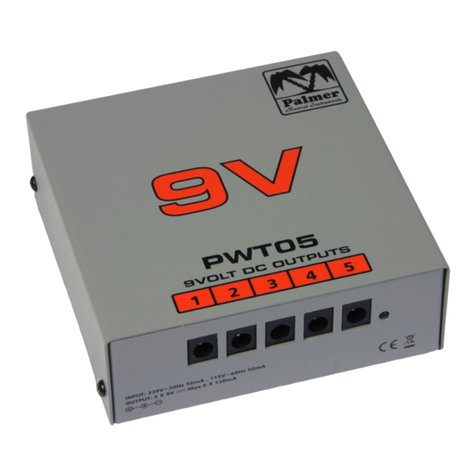
Palmer
Palmer PWT05 user manual
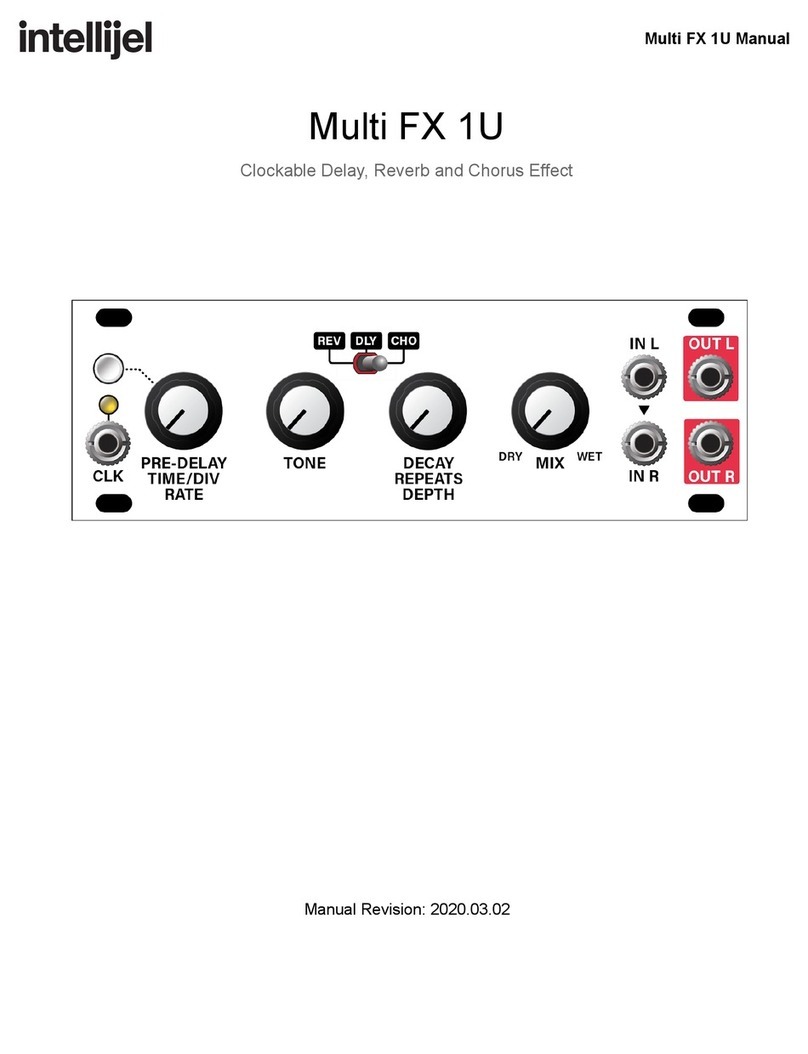
Intellijel
Intellijel Multi FX 1U manual
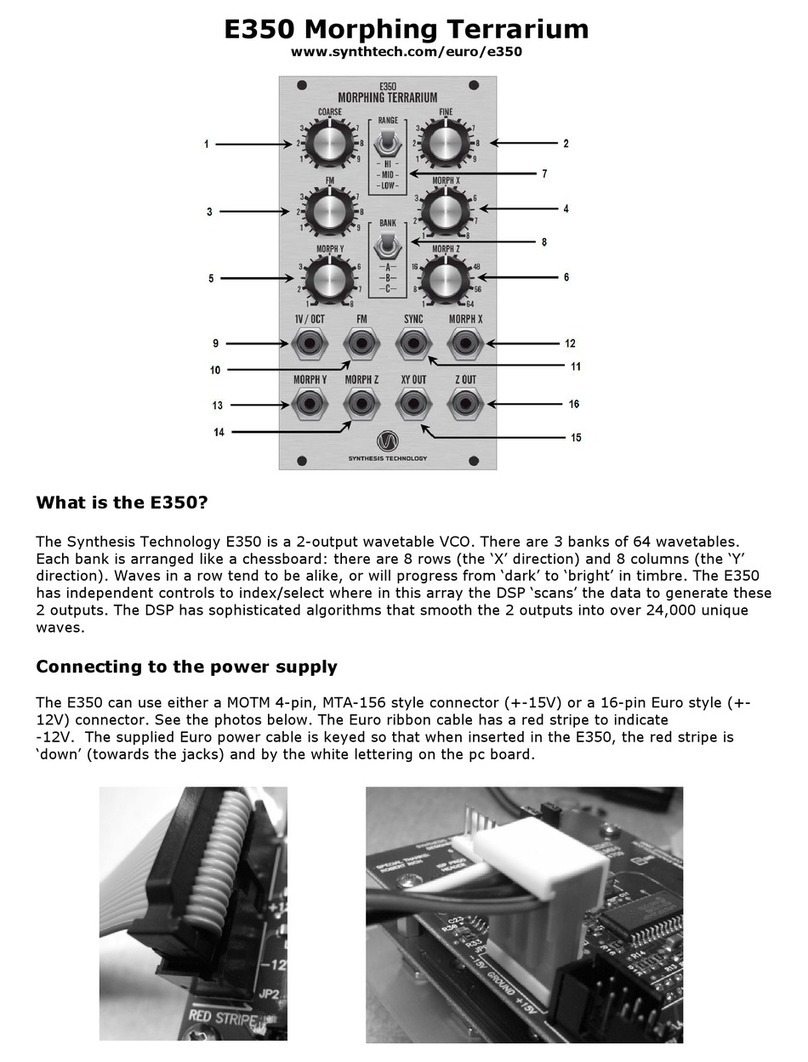
Synthesis Technology
Synthesis Technology E350 Morphing Terrarium user guide

Alesis
Alesis DM10 MKII Pro quick start guide
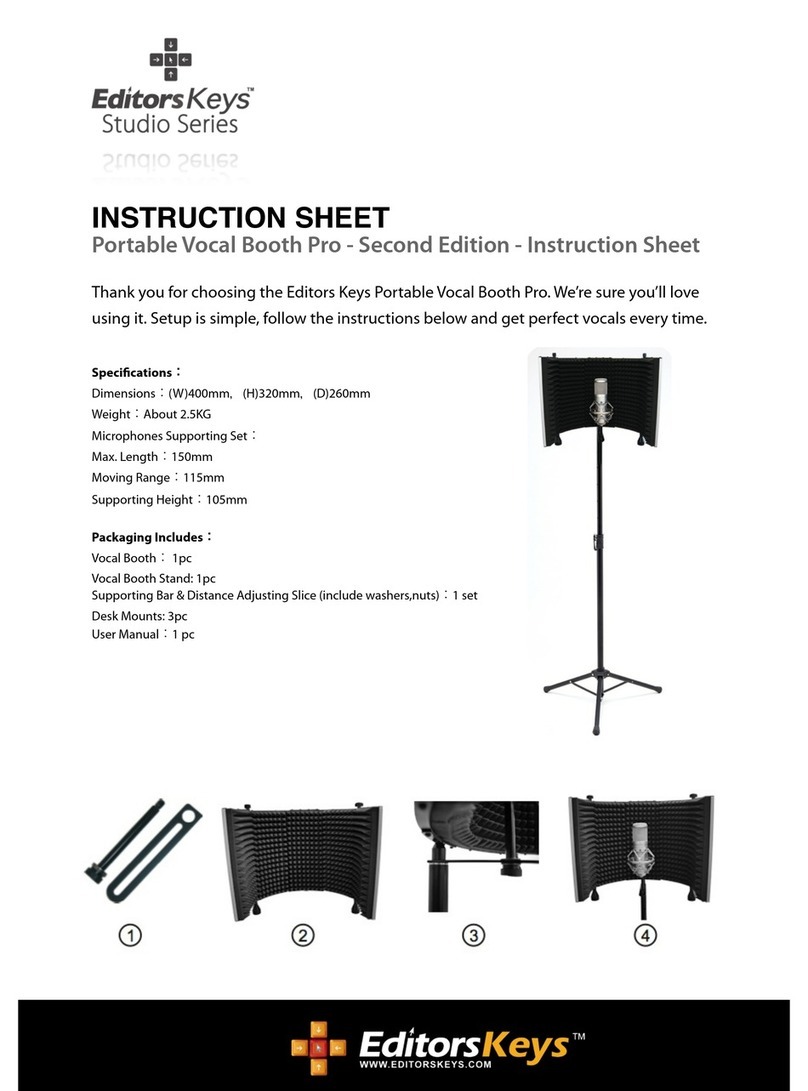
EditorsKeys
EditorsKeys Portable Vocal Booth Pro Studio Series instruction sheet

Musicmakers
Musicmakers BALLAD HARP KIT Assembly instructions
